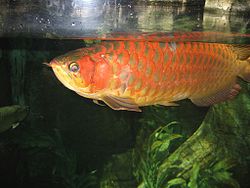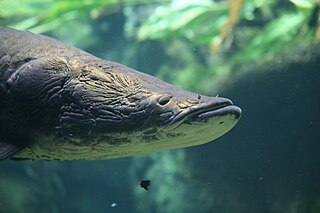
Osteoglossomorpha is a group of bony fish in the Teleostei.

The silver arowana is a South American freshwater bony fish of the family Osteoglossidae. Silver arowanas are sometimes kept in aquariums, but they are predatory and require a very large tank.

The Asian arowana comprises several phenotypic varieties of freshwater fish distributed geographically across Southeast Asia. While most consider the different varieties to belong to a single species, work by Pouyaud et al. (2003) differentiates these varieties into multiple species. They have several other common names, including Asian bonytongue, dragonfish, and a number of names specific to the different color varieties.

Scleropages jardinii, the Gulf saratoga, Australian bonytongue, Pearl arowana or northern saratoga, is a freshwater bony fish native to Australia and New Guinea, one of two species of fishes sometimes known as Australian arowana, the other being Scleropages leichardti. It has numerous other common names, including northern saratoga, toga and barramundi. It is a member of the subfamily Osteoglossinae, a (basal) teleost group. Its scientific name is sometimes spelled S. jardini.

The arapaima, pirarucu, or paiche is any large species of bonytongue in the genus Arapaima native to the Amazon and Essequibo basins of South America. Arapaima is the type genus of the subfamily Arapaiminae within the family Osteoglossidae. They are among the world's largest freshwater fish, reaching as much as 3 m (9.8 ft) in length. They are an important food fish. They have declined in the native range due to overfishing and habitat loss. In contrast, arapaima have been introduced to several tropical regions outside the native range, where they are sometimes considered invasive species. In Kerala, India, arapaima escaped from aquaculture ponds after floods in 2018. Its Portuguese name, pirarucu, derives from the Tupi language words pira and urucum, meaning "red fish".

Osteoglossidae is a family of large freshwater fish, which includes the arowanas and arapaima. The family contains two subfamilies Arapaiminae and Osteoglossinae, with a total of five living genera.

Osteoglossum is a genus of fish in the family Osteoglossidae. They reach about 1 m (3.3 ft) in length and are restricted to freshwater habitats in tropical South America.

Scleropages is a genus of fish in the family Osteoglossidae found in Asia and Australia. All of these species are carnivorous and have great jumping ability. These species are highly valued as aquarium fish, particularly by those from Asian cultures. In 2003, a study redescribed several naturally occurring color varieties of S. formosus into four separate species. The majority of researchers dispute these redescriptions, arguing that the published data are insufficient to justify recognizing more than one Southeast Asian species of Scleropages and that divergent haplotypes used to distinguish the color strains into isolated species were found within a single color strain, contradicting the findings. They are considered monotypic, consisting of closely related haplotypes based on color. The ancestor of the Australian arowanas: S. jardinii and S. leichardti, diverged from the ancestor of the Asian arowanas about 140 million years ago, during the Early Cretaceous period. The morphological similarity of all seven species shows that little evolutionary change has taken place recently for these ancient fish. The genus had a much wider distribution during the early Cenozoic, with fossil remains known from the Paleocene of Niger and Belgium, and from the Eocene of China.
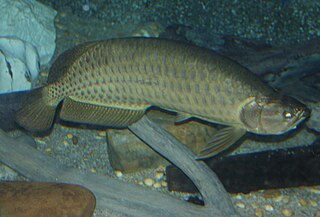
The southern saratoga, also known as the spotted bonytongue, spotted saratoga, or simply saratoga, is a freshwater bony fish native to Australia. It belongs to the subfamily Osteoglossinae, or arowanas, a primitive group of teleosts. Like all arowanas, it is a carnivorous mouthbrooder. Along with the gulf saratoga, the saratoga is also known as the Australian arowana and barramundi, although the latter name is nowadays reserved in Australia for the unrelated Lates calcarifer.

Lycoptera is an extinct genus of fish that lived from Lower Cretaceous, Barremian to Aptian in present-day China, North Korea, Mongolia and Siberia. Although there is record from Jurassic Formation in Siberia, its age remains questionable. It is known from abundant fossils representing sixteen species, which serve as important index fossil used to date geologic formations in China. Along with the genus Peipiaosteus, Lycoptera has been considered a defining member of the Jehol Biota, a prehistoric ecosystem famous for its feathered dinosaurs, which flourished for 20 million years during the Early Cretaceous, where it occurs abundantly in often monospecific beds, where they are thought to have died in seasonal mass death events. Lycoptera is a crown group teleost belonging to an early diverging lineage of the Osteoglossomorpha, which contains living mooneyes, arapaima, arowana, elephantfish and knifefish/featherbacks.
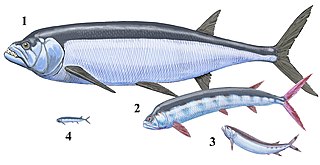
Ichthyodectiformes is an extinct order of marine stem-teleost ray-finned fish. The order is named after the genus Ichthyodectes, established by Edward Drinker Cope in 1870. Ichthyodectiforms are usually considered to be some of the closest relatives of the teleost crown group.
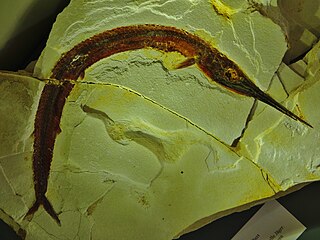
Belonostomus is a genus of prehistoric ray-finned fish that was described by Louis Agassiz in 1844. It is a member of the order Aspidorhynchiformes, a group of fish known for their distinctive elongated rostrums.
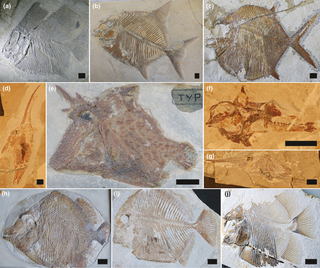
Pycnodontiformes is an extinct order of primarily marine bony fish. The group first appeared during the Late Triassic and disappeared during the Eocene. The group has been found in rock formations in Africa, Asia, Europe, North and South America. They were small to middle-sized fish, generally with laterally-compressed deep bodies, some with almost circular outlines, adapted for manuverability in reef-like environments, though the group was morphologically diverse. Most, but not all members of the groups had jaws with round and flattened teeth, well adapted to crush food items (durophagy), such as echinoderms, crustaceans and molluscs. Some pyncodontiformes developed piranha like teeth used for eating flesh. Most species inhabited shallow marine reef environments, while a handful of species lived in freshwater or brackish conditions. While rare during the Triassic and Early-Middle Jurassic, Pycnodontiformes became abundant and diverse during the Late Jurassic, exhibiting a high but relatively static diversity during the Early Cretaceous. At the beginning of the Late Cretaceous they reached their apex of morphological and species diversity, after which they began to gradually decline, with a more sudden decline at the end of the Cretaceous due to the collapse of reef ecosystems, finally becoming extinct during the Eocene. They are considered to belong to the Neopterygii, but their relationship to other members of that group is uncertain.
Opsithrissops is an extinct genus of prehistoric bony fish that lived during the Thanetian stage of the Paleocene epoch. It is a 120 centimetres (3.9 ft) fish in the family Osteoglossiformes which includes other bony-tongues such as the extant species of arowana and arapaima.

Anaethalion is an extinct genus of prehistoric marine and freshwater ray-finned fish related to modern tarpons and ladyfish. It is known from the Late Jurassic to the Early Cretaceous of Europe and northeasterrn Asia, roughly encompassing the Tethys Ocean.

Brychaetus is an extinct genus of prehistoric bony tongue fish known from the Late Cretaceous to the Eocene. It contains a single species, Brychaetus muelleri. Its fossils have been found in Europe, North America, and northern Africa. This freshwater fish had very long teeth which are half bone and half enamel. It's thought to be related to the modern day arowana although the presence of a sclerotic ossicle in the fossil record would suggest that they were a deep water fish unlike modern day arowanas which are surface feeders.
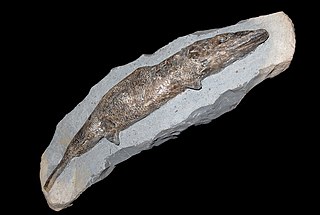
Crossognathiformes is an extinct order of ray-finned fish that lived from the Late Jurassic to the Eocene. Its phylogenetic placement is disputed; some authors have recovered it as part of the teleost stem group, while others place it in a basal position within crown group Teleostei.
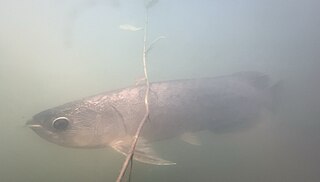
The Batik Arowana or Myanmar arowana(Scleropages inscriptus), is a large, bony-tongued fish native to Myanmar. The species is found in the Tanintharyi River basin on the Indian Ocean coast of peninsular Myanmar.

Arapaiminae is a subfamily of freshwater osteoglossiform (bony-tongued) fishes belonging to the family Osteoglossidae. It includes the South American arapaimas of the Amazon and Essequibo basins and the African arowana from the watersheds of the Sahelo-Sudanese region, Senegal, Gambia, and parts of Eastern Africa. This subfamily is sometimes raised to the rank of family, as Arapaimidae. A commonly used synonym is Heterotidinae, but according to the ICZN, Arapaiminae has priority.

Coccolepididae is an extinct family of ray-finned fish, known from the Early Jurassic to Early Cretaceous, most of which were originally referred to the type genus Coccolepis. They had a widespread distribution, being found in North and South America, Australia, Asia and Europe. They are mostly known from freshwater environments, though several species have been found in marine environments. They are morphologically conservative, and have poorly ossified endo and exoskeletons, which usually results in poor preservation. This makes it difficult to distinguish species. They are generally small fish, with the largest known specimens reaching a length of 210 mm. Historically, they have been classified as members of “Palaeonisciformes”, a paraphyletic grouping of non-neopterygian fish, due to their plesiomorphic conservative morphology closely resembling those of many other groups of primitive fish. They have been suggested to be relatives of the Acipenseriformes within the Chondrostei.

